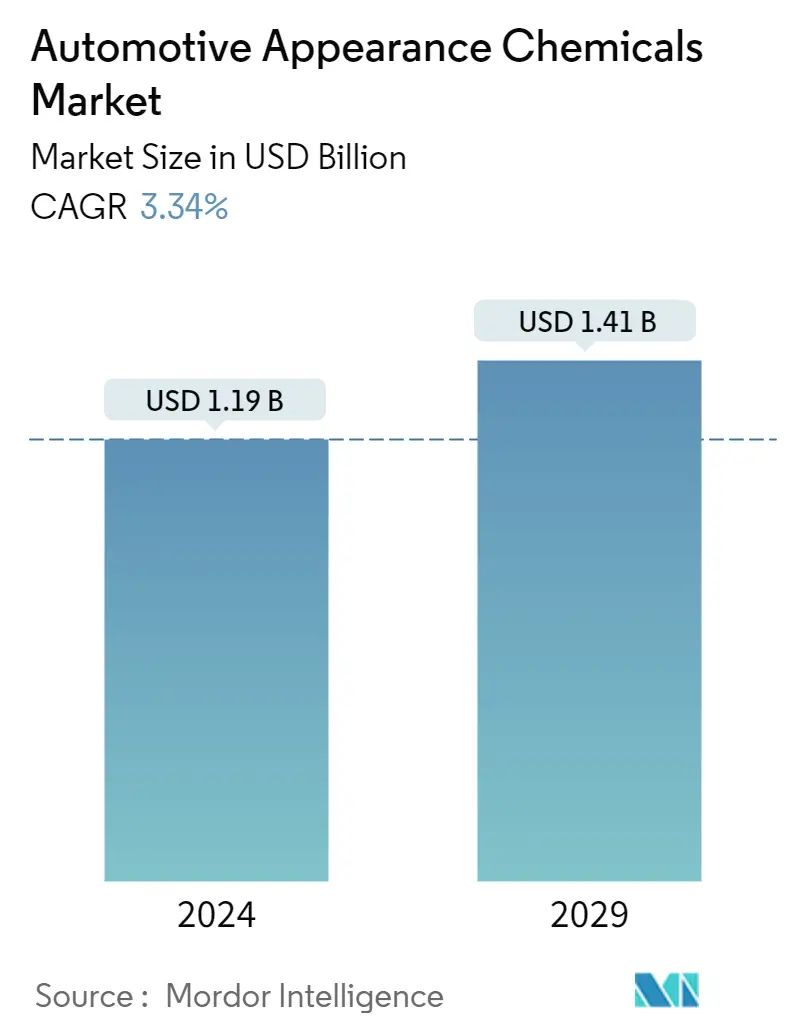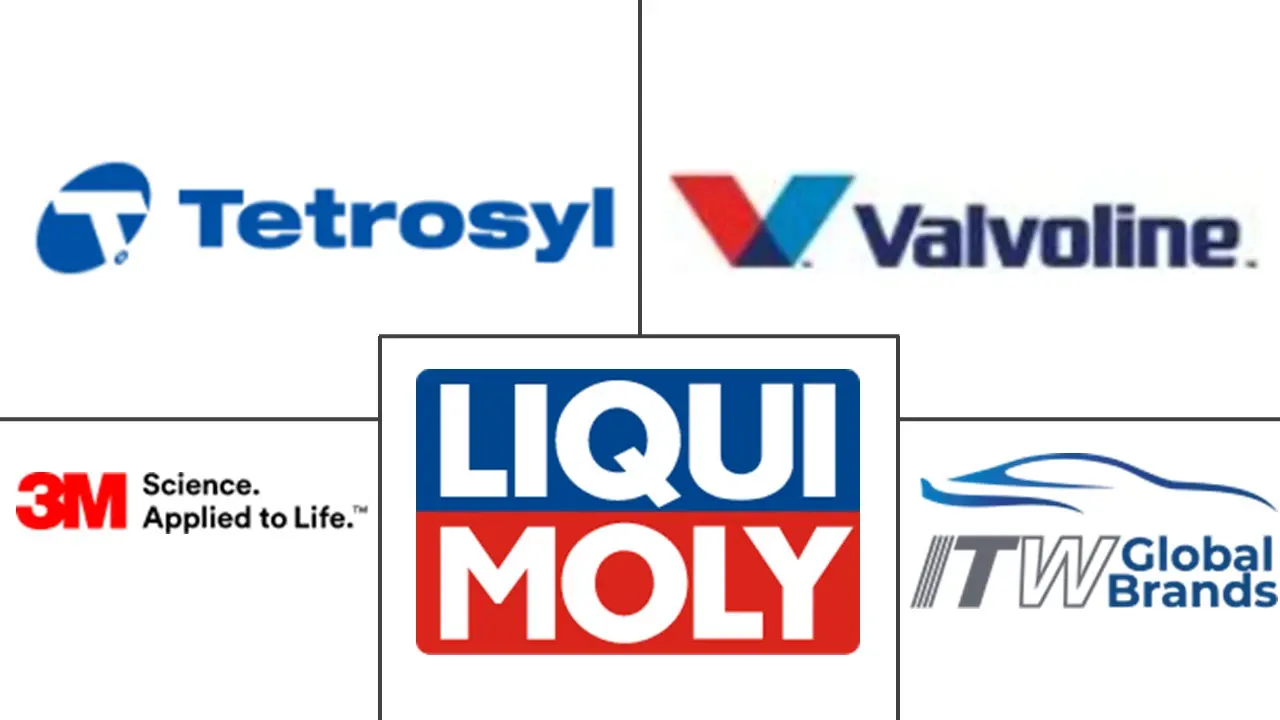Market Size of Automotive Appearance Chemicals Industry

| Study Period | 2019 - 2029 |
| Market Size (2024) | USD 1.19 Billion |
| Market Size (2029) | USD 1.41 Billion |
| CAGR (2024 - 2029) | 3.34 % |
| Fastest Growing Market | Asia Pacific |
| Largest Market | Asia Pacific |
Major Players
*Disclaimer: Major Players sorted in no particular order |
Automotive Appearance Chemicals Market Analysis
The Automotive Appearance Chemicals Market size is estimated at USD 1.19 billion in 2024, and is expected to reach USD 1.41 billion by 2029, growing at a CAGR of 3.34% during the forecast period (2024-2029).
The COVID-19 pandemic affected the global automotive appearance chemicals market. The slowdown in global automobile production during the period resulted in minimal market growth in 2020. However, the market recovered from the pandemic and is growing significantly.
- Over the short term, the increase in the production of electric vehicles (EV) and consumer awareness toward vehicle maintenance are major factors driving the growth of the market studied.
- However, stringent government regulations on petroleum products such as waxes and coatings are likely to restrain the growth of the studied market.
- Nevertheless, the increasing adoption of professional auto care services and modern technology in specialized applications will likely create lucrative growth opportunities for the global market.
- The Asia-Pacific region represents the largest market. It is also expected to be the fastest-growing market over the forecast period, owing to the increasing consumption in countries such as China, India, and Japan.
Automotive Appearance Chemicals Industry Segmentation
Automotive appearance chemicals aid in cleaning and removing dirt from automobiles while improving their shine and durability. It also enhances the appearance of the vehicle's body during maintenance and post-wear and tear incidence. Phosphates, colorants, perfumes, water, solvents, oils, abrasives, surfactants, emulsifiers, silicones, and synthetic waxes are used in their production. The automotive appearance chemicals market is segmented by product type, application, and geography. The market is segmented by product type into waxes, polishes, protectants, wheel & tire cleaners, windshield washer fluids, leather care products, and others. The market is segmented by application into passenger cars, light commercial vehicles, heavy commercial vehicles, and others. The report also covers the market sizes and forecasts for the automotive appearance chemicals market in 15 countries across major regions. Each segment's market sizing and forecasts are based on revenue (USD).
| Product Type | |
| Waxes | |
| Polishes | |
| Protectants | |
| Wheel and Tire Cleaners | |
| Windshield Washer Fluids | |
| Leather Care Products | |
| Others |
| Application | |
| Passenger Cars | |
| Light Commercial Vehicles | |
| Heavy Commercial Vehicles | |
| Others |
| Geography | |||||||
| |||||||
| |||||||
| |||||||
| |||||||
|
Automotive Appearance Chemicals Market Size Summary
The automotive appearance chemicals market is experiencing a positive trajectory, driven by the increasing production of electric vehicles (EVs) and heightened consumer awareness regarding vehicle maintenance. The market, which faced challenges during the COVID-19 pandemic due to a slowdown in global automobile production, has since rebounded and is on a growth path. The rise in EV production is particularly significant, as it aligns with global efforts towards sustainable transportation and energy efficiency. However, the market's expansion is somewhat tempered by stringent government regulations on petroleum-based products like waxes and coatings. Despite these challenges, the adoption of professional auto care services and advancements in technology for specialized applications present promising growth opportunities.
The Asia-Pacific region stands out as the largest and fastest-growing market for automotive appearance chemicals, fueled by robust vehicle manufacturing and consumption in countries such as China, India, and Japan. These nations are enhancing their manufacturing capabilities and supply chains, contributing to the region's market dominance. The fragmented nature of the market sees major players like 3M, LIQUI MOLY GmbH, ITW Global Brands, Valvoline, and Tetrosyl Ltd. actively participating in the competitive landscape. As the demand for automotive appearance chemicals continues to rise, driven by the factors mentioned, the market is poised for significant growth over the forecast period.
Automotive Appearance Chemicals Market Size - Table of Contents
-
1. Market Dynamics
-
1.1 Drivers
-
1.1.1 Increase in the Production of Electric Vehicles (EV)
-
1.1.2 Increase in Consumer Awareness Toward Vehicle Maintenance
-
1.1.3 Other Drivers
-
-
1.2 Restraints
-
1.2.1 Stringent Government Regulations on Petroleum Products like Waxes and Coatings
-
1.2.2 Other Restraints
-
-
1.3 Industry Value Chain Analysis
-
1.4 Porter's Five Forces Analysis
-
1.4.1 Bargaining Power of Suppliers
-
1.4.2 Bargaining Power of Consumers
-
1.4.3 Threat of New Entrants
-
1.4.4 Threat of Substitute Products and Services
-
1.4.5 Degree of Competition
-
-
-
2. MARKET SEGMENTATION (Market Size in Value)
-
2.1 Product Type
-
2.1.1 Waxes
-
2.1.2 Polishes
-
2.1.3 Protectants
-
2.1.4 Wheel and Tire Cleaners
-
2.1.5 Windshield Washer Fluids
-
2.1.6 Leather Care Products
-
2.1.7 Others
-
-
2.2 Application
-
2.2.1 Passenger Cars
-
2.2.2 Light Commercial Vehicles
-
2.2.3 Heavy Commercial Vehicles
-
2.2.4 Others
-
-
2.3 Geography
-
2.3.1 Asia-Pacific
-
2.3.1.1 China
-
2.3.1.2 India
-
2.3.1.3 Japan
-
2.3.1.4 South Korea
-
2.3.1.5 Rest of Asia-Pacific
-
-
2.3.2 North America
-
2.3.2.1 United States
-
2.3.2.2 Canada
-
2.3.2.3 Mexico
-
-
2.3.3 Europe
-
2.3.3.1 Germany
-
2.3.3.2 United Kingdom
-
2.3.3.3 France
-
2.3.3.4 Italy
-
2.3.3.5 Rest of Europe
-
-
2.3.4 South America
-
2.3.4.1 Brazil
-
2.3.4.2 Argentina
-
2.3.4.3 Rest of South America
-
-
2.3.5 Middle-East and Africa
-
2.3.5.1 Saudi Arabia
-
2.3.5.2 South Africa
-
2.3.5.3 Rest of Middle-East and Africa
-
-
-
Automotive Appearance Chemicals Market Size FAQs
How big is the Automotive Appearance Chemicals Market?
The Automotive Appearance Chemicals Market size is expected to reach USD 1.19 billion in 2024 and grow at a CAGR of 3.34% to reach USD 1.41 billion by 2029.
What is the current Automotive Appearance Chemicals Market size?
In 2024, the Automotive Appearance Chemicals Market size is expected to reach USD 1.19 billion.

